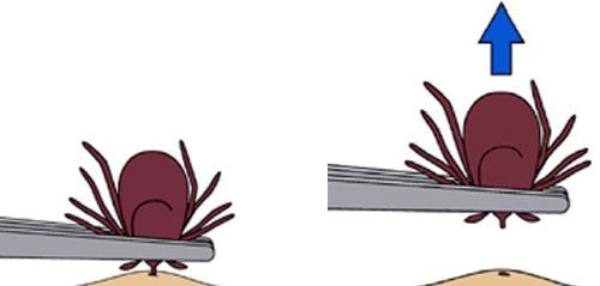The tiny disease-carrying, blood-sucking parasites known as “ticks” benefit the moist and dark ecosystems in which they live by serving as food for other species. Scientists even use them as an indicator of an ecosystem’s overall health and stability.
Food Source
When ticks are feeding on you or your pets, it’s easy to forget other species are feeding on them. Ticks are an important food source for several species of reptiles, amphibians, and birds. Many woodland animals feed on them as well, including wild turkeys and western fence lizards.
Ecosystem Indicator
Ecologists monitor tick populations to gain a better understanding of the health of ecosystems. An increase in tick populations may indicate a decrease in the predators of small mammals. For example, a study of timber rattlesnake populations in the eastern United States found that healthy snakes will eliminate thousands of ticks every year by eating mice and other small mammals on which ticks feed. Ecosystems with thriving snake populations have smaller populations of ticks, so an increase in ticks may indicate a problem within the snake population.
Diseases Transmitted by Ticks
In the United States, ticks may carry the pathogens that cause over sixteen different human diseases including Anaplasmosis, Babesiosis, Colorado Tick Fever, Heartland Virus, Lyme Disease, and Tularemia. Many of these diseases are life-threatening, especially in people with weakened or comprised immune systems. Learn more about these diseases, symptoms, and treatments by visiting https://www.cdc.gov/ticks/diseases/index.html.
Preventing Tick Bites
Tick exposure can occur year-round, but ticks are most active during warmer months, typically April through September. Ticks are generally found near the ground in brushy or wooded areas. They can’t jump or fly. Instead, they climb tall grasses or shrubs and wait for you or your pet to brush against them. When this happens, they climb on and seek a site to attach themselves.
Before You Go Outdoors:
Know where to expect ticks. Ticks live in grassy, brushy, or wooded areas, or even on animals. Spending time outside walking your dog, camping, gardening, or hunting could bring you in close contact with ticks.
Treat clothing and gear with products containing 0.5% permethrin. Permethrin can be used to treat boots, clothing, and camping gear and remains protective through several washings.
Use Environmental Protection Agency (EPA)-registered insect repellents containing DEET, picaridin, IR3535, Oil of Lemon Eucalyptus (OLE), para-menthane-diol (PMD), or 2-undecanone.
Avoid Contact with Ticks
Avoid wooded and brushy areas with high grass and leaf litter.
Walk in the center of trails.
After You Come Indoors:
Check your clothing for ticks. Ticks may be carried into the house on clothing. Any ticks that are found should be removed. Tumble dry clothes in a dryer on high heat for 10 minutes to kill ticks on dry clothing. If the clothes are damp, additional time may be needed. If the clothes require washing first, hot water is recommended. Cold and medium temperature water will not kill ticks.
Examine gear and pets. Ticks can ride into your home on clothing and pets, then attach to you later. Be sure to carefully examine pets, coats, and daypacks.
Shower soon after being outdoors. Showering within two hours of coming indoors has been shown to reduce your risk of getting Lyme disease and may be effective in reducing the risk of other tickborne diseases. Showering may wash off unattached ticks and provides a good opportunity to do a quick tick check.
Check your body for ticks after being outdoors. Conduct a full body check upon return from potentially tick-infested areas, including your own backyard. Use a hand-held or full-length mirror to view all parts of your body.

Tick Removal
If you find a tick attached to your skin, there’s no need to panic. However, it is recommended to remove the tick as soon as possible. Avoid folklore remedies such as “painting” the tick with nail polish or petroleum jelly or using heat to make the tick detach from the skin. Your goal is to remove the tick as quickly as possible – not waiting for it to detach. There are several tick removal devices on the market, but a plain set of fine-tipped tweezers will do the trick.
How to remove a tick
Use fine-tipped tweezers to grasp the tick as close to the skin’s surface as possible.
Pull upward with steady, even pressure. Don’t twist or jerk the tick; this can cause the mouthparts to break off and remain in the skin. If this happens, remove the mouthparts with tweezers. If you are unable to remove the mouth easily with clean tweezers, leave it alone and let the skin heal.
After removing the tick, thoroughly clean the bite area and your hands with rubbing alcohol or soap and water.
Never crush a tick with your fingers. Dispose of a live tick by putting it in alcohol, placing it in a sealed bag/container, wrapping it tightly in tape, or flushing it down the toilet.
 Follow-up
Follow-up
If you develop a rash or fever within several weeks of removing a tick, see your doctor. Be sure to tell the doctor about your recent tick bite, when the bite occurred, and where you most likely acquired the tick.
Friend OR Foe?
Well, that’s up to you to decide. However, you should follow proper precautions to avoid tick bites, remove ticks completely and safely if discovered on you or others, and seek proper medical attention if necessary.
Content Sources:
Centers for Disease Control and Prevention
Article by Sarah Cairoli titled “What Purpose Do Ticks Serve in the Ecosystem?”


